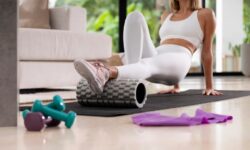
In the realm of fitness and strength training, versatility is key. Enter resistance bands – the compact, affordable, and highly adaptable tools that have revolutionized the way we approach workouts. Among the myriad of accessories available for resistance bands door anchors, the door anchor stands out as a fundamental piece, offering convenience and expanding the range of exercises achievable with these simple yet effective tools. In this comprehensive guide, we’ll delve into the world of resistance band door anchors, exploring their benefits, usage, safety considerations, and a plethora of exercises to maximize your workout potential.
Understanding Resistance Bands
Before we delve into the specifics of door anchors, let’s briefly review what resistance bands are and why they’re such a popular choice for fitness enthusiasts.
What are Resistance Bands?
Resistance bands, also known as exercise bands or workout bands, are elastic bands used for strength training and rehabilitation exercises. They come in various shapes, sizes, and resistance levels, catering to individuals of all fitness levels and goals.
Benefits of Resistance Bands
Portability: Unlike bulky gym equipment, resistance bands are lightweight and portable, making them ideal for home workouts, travel, or outdoor exercise sessions.
Versatility: From muscle building to flexibility training, resistance bands offer a wide range of exercises targeting different muscle groups, accommodating various fitness goals and preferences.
Joint-Friendly: Resistance bands provide constant tension throughout the range of motion, reducing stress on joints compared to traditional free weights.
Cost-Effective: Compared to gym memberships or purchasing expensive equipment, resistance bands are a cost-effective alternative without compromising on workout quality.
Suitable for All Fitness Levels: Whether you’re a beginner or an advanced athlete, resistance bands can be easily adjusted to match your strength and fitness level.
Introducing the Door Anchor
Among the accessories designed to enhance the effectiveness of resistance bands, the door anchor stands out as a game-changer. This simple yet ingenious device allows users to anchor their resistance bands to a sturdy door, expanding the range of exercises that can be performed. Let’s explore the components and benefits of a door anchor.
Components of a Door Anchor
A typical resistance band door anchor consists of the following components:
Nylon Strap: The main body of the door anchor, usually made of durable nylon material, designed to withstand tension and abrasion.
Foam Padding: Many door anchors feature foam padding on one side to protect the door from damage and provide a comfortable grip for the user.
Attachment Point: A metal or plastic loop at one end of the strap where the resistance band is attached securely.
Benefits of Using a Door Anchor
Enhanced Versatility: By securing the resistance band to a door anchor, users can perform a wide range of exercises that mimic traditional gym equipment, such as cable machines or pulley systems.
Convenience: With a door anchor, you can transform any sturdy door into a makeshift workout station, eliminating the need for specialized equipment or dedicated workout spaces.
Space-Saving: Ideal for home gyms or small living spaces, door anchors offer a space-saving solution without compromising on workout variety or intensity.
Stability and Safety: A properly secured door anchor provides stability and prevents slippage during exercises, reducing the risk of injury associated with unstable anchoring points.
Adjustable Resistance: Users can easily adjust the resistance level by varying the distance between the door anchor and the attachment point, allowing for progressive overload and tailored workouts.
Choosing the Right Door Anchor
Not all door anchors are created equal. When selecting a door anchor for your resistance band workouts, consider the following factors:
Durability: Opt for a door anchor made of high-quality materials, such as reinforced nylon and sturdy metal components, to ensure longevity and reliability.
Compatibility: Ensure that the door anchor is compatible with your resistance bands in terms of size, attachment method, and weight capacity.
Adjustability: Look for a door anchor with adjustable straps or multiple attachment points to accommodate different door sizes and exercise variations.
Safety Features: Choose a door anchor with foam padding or protective coverings to prevent damage to the door and provide a comfortable grip for the user.
Brand Reputation: Research reputable brands known for manufacturing quality fitness accessories and read customer reviews to gauge satisfaction and reliability.
Using a Door Anchor Safely
While resistance band door anchors are relatively simple to use, it’s essential to follow safety guidelines to prevent accidents or injuries. Here are some safety tips to keep in mind:
Inspect the Door: Before attaching the door anchor, ensure that the door is sturdy, securely mounted, and free from any obstructions or hazards that may interfere with your workout.
Secure Attachment Point: Choose a solid, non-hollow part of the door frame or hinge side for anchoring the door strap. Avoid attaching the door anchor to weak or damaged surfaces that may fail under tension.
Proper Alignment: Position the door anchor at chest height or slightly above to maintain proper alignment and range of motion during exercises. Avoid placing the door anchor too high or too low, which can strain the muscles or cause discomfort.
Check Resistance Band Condition: Inspect your resistance bands regularly for signs of wear and tear, such as fraying, stretching, or weakening. Replace damaged bands immediately to prevent breakage during workouts.
Gradual Progression: Start with light resistance and gradually increase the intensity as your strength and fitness level improve. Avoid sudden movements or jerky motions that may strain muscles or joints.
Maintain Proper Form: Focus on maintaining proper posture and form throughout each exercise to maximize effectiveness and reduce the risk of injury. Engage the core muscles, stabilize the joints, and move through a full range of motion with control and precision.
Listen to Your Body: Pay attention to any discomfort, pain, or unusual sensations during workouts. If you experience pain or discomfort, stop the exercise immediately and consult a fitness professional or healthcare provider if necessary.
Exercises Using a Door Anchor
Now that you’re familiar with the benefits and safety considerations of using a resistance band door anchor, let’s explore a variety of exercises you can incorporate into your workout routine:
Standing Chest Press: Attach the resistance band to the door anchor at chest height. Stand facing away from the door, holding the handles in each hand. Extend your arms forward, then press them outward until fully extended, engaging the chest muscles. Slowly return to the starting position and repeat.
Seated Row: Sit on the floor facing the door, legs extended, and feet against the door for stability. Hold the resistance band handles with both hands, palms facing each other. Pull the handles towards your chest, squeezing the shoulder blades together. Slowly release and repeat.
Lateral Raises: Stand sideways to the door, holding the resistance band handle in your outside hand. Keep your arm straight and lift it out to the side until it reaches shoulder height, then lower it back down slowly. Repeat on both sides.
Triceps Extension: Attach the resistance band to the door anchor at shoulder height. Stand facing away from the door, holding the handle in one hand. Extend your arm overhead, keeping the elbow close to your head. Straighten your arm fully, then lower it back down behind your head. Repeat on both sides.
Standing Bicep Curl: Stand facing the door, feet shoulder-width apart, and hold the resistance band handles with palms facing upward. Keep your elbows close to your sides as you curl the handles towards your shoulders, squeezing the biceps. Slowly lower the handles back down and repeat.
Standing Leg Abduction: Attach the resistance band to the door anchor at ankle height. Stand facing the door, with one ankle secured in the handle. Lift the secured leg out to the side against the resistance of the band, then return to the starting position. Repeat on both sides.
Standing Hip Flexion: Attach the resistance band to the door anchor at ankle height. Stand facing away from the door, with one ankle secured in the handle. Lift the secured leg forward, bringing the knee towards your chest, then lower it back down. Repeat on both sides.
Woodchopper: Attach the resistance band to the door anchor at shoulder height. Stand sideways to the door, holding the handle with both hands. Pull the handle across your body diagonally, rotating your torso and pivoting on your back foot. Slowly return to the starting position and repeat on both sides.
Standing Pallof Press: Attach the resistance bands to the door anchors at chest height. Stand perpendicular to the door, holding the handle with both hands. Extend your arms straight out in front of you, then press the handle away from your body, resisting the pull of the band. Hold for a few seconds, then return to the starting position and repeat.
Standing Anti-Rotation Press: Attach the resistance band to the door anchor at chest height. Stand facing the door, holding the handle with both hands at chest level. Press the handle forward, away from your body, while resisting the tendency to rotate. Hold for a few seconds, then return to the starting position and repeat.
Conclusion
Resistance bands door anchors are invaluable accessories that unlock a world of possibilities for home workouts and on-the-go training. With proper technique, safety precautions, and a bit of creativity, you can achieve a full-body workout targeting all major muscle groups using nothing more than a resistance band and a sturdy door. Whether you’re a beginner looking to kickstart your fitness journey or an experienced athlete seeking to spice up your routine, the door anchor is a versatile tool that caters to all fitness levels and goals. So, grab your resistance bands, secure that door anchor, and let the gains begin!








